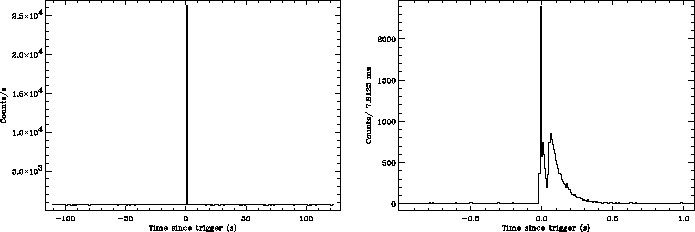



Next: Solar X-ray Flares
Up: Medium and Short Time
Previous: The continuum component
Contents
The most prolific source of background noise is represented by the
spikes in the ratemeters produced by passages of high-energy charged
particles through the detector slabs.
These excess counts in the 1 s ratemeters involve single bins at a time
and mostly affect the GRBM band: in fact, the poissonian component of the
background noise in the AC counts is the most relevant, as already shown
in the previous paragraph (see table ![[*]](crossref.png) ).
Therefore, two main features characterize them: the spectral
softness, of key importance for distinguishing them from GRBs,
and the HTR temporal profile, shaped like a fast rise followed by
an exponential decay (fig.
).
Therefore, two main features characterize them: the spectral
softness, of key importance for distinguishing them from GRBs,
and the HTR temporal profile, shaped like a fast rise followed by
an exponential decay (fig. ![[*]](crossref.png) ).
).
Figure:
Example of a strong spike occurred in unit 1, GRBM band,
at 11:25:43.06 UT, on August 26, 2001.
Left panel: 1 s bin profile; right panel: same profile with a 7.8125 ms
resolution. The typical exponential decay is clearly visible: in this
case, a least square fit estimates the exponential decay constant
 ms,
ms,
 . The dip, visible
in the middle of the HTR pulse, is fake and it is due to the
6 bit counters' recycling.
. The dip, visible
in the middle of the HTR pulse, is fake and it is due to the
6 bit counters' recycling.
 |
The explanation of the fact that a single particle is responsible for
several  counts within one second is the following:
these particles are often cosmic
rays with a high atomic number Z, that excite metastable states
of the CsI(Na) crystal of the crossed detector: the time required for
these states to de-excite is a fraction of 1 s (up to few 100 ms),
which is long when compared to the response times of the on-board electronics:
therefore, the phosphorescence light produced in the decay is
processed and converted into several counts ([Emigh and Megill, 1954,Hurley, 1978]).
counts within one second is the following:
these particles are often cosmic
rays with a high atomic number Z, that excite metastable states
of the CsI(Na) crystal of the crossed detector: the time required for
these states to de-excite is a fraction of 1 s (up to few 100 ms),
which is long when compared to the response times of the on-board electronics:
therefore, the phosphorescence light produced in the decay is
processed and converted into several counts ([Emigh and Megill, 1954,Hurley, 1978]).




Next: Solar X-ray Flares
Up: Medium and Short Time
Previous: The continuum component
Contents
Cristiano Guidorzi
2003-07-31

![[*]](crossref.png) ).
Therefore, two main features characterize them: the spectral
softness, of key importance for distinguishing them from GRBs,
and the HTR temporal profile, shaped like a fast rise followed by
an exponential decay (fig.
).
Therefore, two main features characterize them: the spectral
softness, of key importance for distinguishing them from GRBs,
and the HTR temporal profile, shaped like a fast rise followed by
an exponential decay (fig. ![[*]](crossref.png) ).
).
